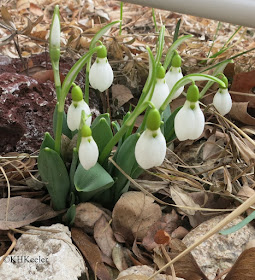The snowdrop, Galanthus nivallis is one of those.
 |
| snowdrops, almost open |
These diminutive plants grow from bulbs. Native to the mountains of Europe and southwestern Asia, they are grown all over Europe as early spring flowers and have naturalized there and in the eastern United States.
Snowdrops have some 20 related species in the genus Galanthus, found from Europe into the Middle East. They are classified in the large, diverse amaryllis family (Amaryllidaceae ). (As are onions, see last week's post link). Like snowdrops, most species of Galanthus flower in very early spring (before the spring equinox) and are very tolerant of cold and snow.
 |
| the snow-piercing tips of snowdrops |
People were pleased to see snowdrops in flower. In many parts of Europe snowdrops are the very first plant to flower. Generally in flower in England by February 1, they were consequently called Candlemas bells and incorporated into the celebration of Candlemas, the Purification of Saint Mary, on February 2. They were used to decorate the altar and worn by young girls.
 |
| snowdrop flower |
“The snowdrop, in purest white arraie
First rears her hedde on Candlemas daie.”
--An Early Calendar of English Flowers in Garden Flower Folklore
Thou first-born of the year's delight
Pride of the dewy glade,
In vernal green, and virgin white
They vestal robes array'd.
--Keble in Nature Notes of an Edwardian Lady
Despite all this positive symbolism, country folk in England frequently considered snowdrops ill-omened. Picking snowdrops and bringing them into the house meant there would be a death in the immediate family. Mid-20th century florists reportedly refused to sell them because of the bad luck they brought. Perhaps this reputation stems from the fact that they emerge from ground wrapped in white sheaths, as if the plant were a tiny body prepared for burial. Another possibility is that since they often grow in graveyards, they developed a sinister association with death. Other white flowers are associated with death, so bad luck from snowdrops may be part of a general reaction.
 |
| Snowdrop buds in their sheath. |
My yard had snowdrops when I bought it 10 years ago. They persisted with no help from me and spread when I protected them from being stepped on. Here in northern Colorado I don't see them as early as Candlemas, but often they are up the next week and certainly by the first of March. They do well under my maple tree because there they get full sun in early spring but are shaded from the drying Colorado sun later in the growing season.
The foliage disappears by late spring as the bulbs go dormant. This seems tidy but can be a problem. I would like to divide one of my clumps and move another to what I hope is a better location. For two years now, I haven't been able to find the plants in the fall to move them, despite digging where I'd left a marker. I still want to move them, so I'll mark them more carefully this spring and hope for better luck next fall.
 |
| snowdrops |
Looking in the Oxford English dictionary at "snowdrop," I found that in addition to the flower, it is a name for a military policeman. Apparently it began with Second World War-era American military policemen who wore distinctive white helmets. That uniform isn't worn any more, but, at least in some places, the name persists. You have to enjoy the British whimsey, nicknaming tough military policemen delicate flowers. See pictures: Link1; link2; link3.
Watch for this year's snowdrops.
Comments and corrections welcome.
References
Holden, E. The Natures Notes of an Edwardian Lady. Archade Publishing, New York (1905)
Martin, L. C. Garden Flower Folklore The Globe Pequot Press, Chester Connecticut (1987)
Wikipedia Snowdrops https://en.wikipedia.org/wiki/Galanthus Accessed 1/13/16
Kathy Keeler
More at awanderingbotanist.com
Join me on Facebook: https://www.facebook.com/AWanderingBotanist
Buy the book! Curious Stories of Familiar Garden Plants by Kathy Keeler, A Wandering Botanist. This story and more! Now available on Amazon link
I enjoy your plant history and story telling. A wonderful combination.
ReplyDelete